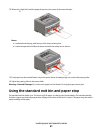
Paper and specialty media guide
Paper guidelines
Paper capacities
The capacities of the trays and the manual feeder are based on 75 g/m
2
(20 lb) paper.
Load up to Notes
Tray 1
250 sheets of paper
150 sheets of A6-size paper
50 paper labels
50 transparencies
Vinyl, pharmacy, or dual-sided labels are not supported. Use paper
labels only. Single-sided paper labels designed for laser printers
are supported for occasional use.
Tray 2
250 or 550 sheets of paper
50 paper labels
Only one optional drawer may be installed on the printer at a time.
The maximum amount of paper that can be loaded depends on
whether you have an optional 250- or 550-sheet tray.
Vinyl, pharmacy, or dual-sided labels are not supported. Use paper
labels only. Single-sided paper labels designed for laser printers
are supported for occasional use.
Manual feeder
1 sheet of paper
1 sheet of A6-size paper
1 transparency
1 sheet of card stock
1 envelope
Feed paper into the manual feeder only to the point where its
leading edge can contact the paper guides. Do not force the paper
into the feeder.
Paper characteristics
The following paper characteristics affect print quality and reliability. Consider these characteristics when evaluating
new paper stock.
Weight
The printer trays can automatically feed paper weights up to 90 g/m
2
(24 lb bond) grain long paper. The manual
feeder can automatically feed paper weights up to 163 g/m
2
(43 lb bond) grain long paper. Paper lighter than
60 g/m
2
(16 lb) might not be stiff enough to feed properly, causing jams. For best performance, use 75 g/m
2
(20 lb
bond) grain long paper. For paper smaller than 182 x 257 mm (7.2 x 10.1 in.), we recommend 90 g/m
2
(24 lb) or heavier
paper.
Note: Duplex printing is supported only for 60–90 g/m
2
(16–24 lb bond) paper.
Paper and specialty media guide
64


















